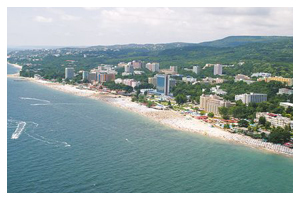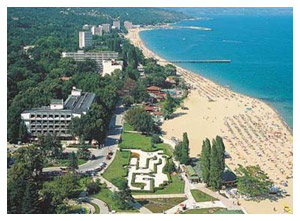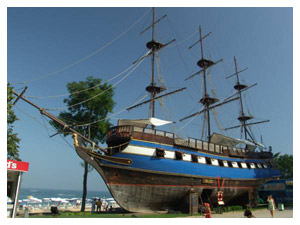
Pirates dug in huge golden treasure in the coast north of Varna. The land took revenge on the bandits and transformed the gold into wonderful sand
Golden Sands is located in a picturesque and environmentally-clean bay in the Northern part of the Black Sea coast, only 10 km. south of Hills and Sea Complex and 18km north of Varna. It was declared a protected territory in 1943. The larger part of the park is preserved in its natural state, untouched by human hand. The proximity of the sea, the mild climate and the sea breeze have influenced strongly the flora and fauna in the park which is why it differs greatly from the other national parks. The thick deciduous forest with entwined creeping plants in places gently descends to the seacoast. There are many eating, sports and entertainment facilities, not only along the beach but also in the beautiful woods. The golden beach starts right in the foot of the forest. The resort also boasts a number of healing mineral springs.Golden Sands is the winner of a "Blue Flag" – a prestigious international award for environmentally clean resorts. The major microbiological, physical and chemical readings of the atmosphere, sea and sand are monitored monthly. Within the resort, several types of transportation are at the disposal of the guests – velorikshaws, bicycles, mini-trains, and solar-battery powered taxies.
 Sea and Beach
Sea and Beach
The beach strip in the resort is 3,5 km long, up to 100m in places, and is known as one of the best sand beaches in Europe. It is flat, covered with fine golden sand. The sandy sea bottom gently slopes into the sea, there are no rocks or sudden drops.
The clean and calm waters of the sea with low salinity lower than that of the Mediterranean for example, and the absence of fish and animals dangerous to human health, are ideal for scuba diving and vacationing with children.
Climate
The climate is mild, temperate continental, similar to that in the famous Mediterranean resorts.
Average daytime temperature during the summer months is: air - 27 °С, sea water -24°С.
Summers are long and warm, suitable for sunbathing from May to October. The heat is not overpowering thanks to the sea breeze. Changes of temperature are not drastic.The mild weather in early spring and late autumn is ideally suited for water- and sea treatments, as well as congress and conference events and short term holidays.
Sport and Recreation
At the disposal of all visitors are: A rich variety of water sports in five sports centres located along the beach – water skis, jet, wind surfing, pedalos, banana, water parachute, yachts for sailing, fishing.
-marina with 100 berths
-scuba diving school
-dive center
-several red clay outdoor tennis courts located near Morsko Oko Hotel complex and Lilia Hotel offer -training by professionals for children and adults.
-bowling room
-volleyball and basketball
-riding school
-mini-golf
-bicycles and velorickshaws
-fitness centres in hotels
-outdoor swimming pools and jacuzzi
-archery
-bungee jumping
-darts
-table tennis
-billiards
Tournaments in beach volleyball and street ball, tennis and ping pong, sailing regattas are organized for aficionados of these sports.
The rehabilitation centres include a variety of cosmetic and rehabilitation procedures
-medical and dental services
-massage – underwater or manual, includingSaiongy massage
-electrotherapy zone therapy
-water treatment with pearl baths
-aromatherapy – baths and massages with aromatic oils
-thalassotherapy
-relaxation and anti-stressprograms, including massages, baths and body packs with Talion products
-anti-cellulite and weight-loss programs
-physiotherapy
-medical exercises
-use of the healing properties of mineral water
-sauna
-solarium
-individual water treatment and cosmetic programs
 Childern's world
Childern's world
For its youngest guests, Golden Sands organize a number of sports events, games and amusements, kids' discos, unforgettable meetings with favourite toon characters in puppet shows.
-pony rides
-archery sites
-water slides
-mini-golf
-computer and arcade games
-toy trains
-inflatable castles
-karting
-colouring of clay figures
-kid wading pools
Night Fun
With nightfall, an endless fiesta of light, sound and night entertainment begins at Golden Sands. Variety shows amid exotic atmosphere, splendid cuisine and exquisite drinks - and gradually you join in the party under the stars.
Roulettes, slot machines, black jack and many more games of luck will provoke the gambling spirit you have never suspected you have.
If you feel like dancing, modern nightclubs along the beach will be the place for you. And finally your night can end with a cocktail at one of the numerous small beach bars.
Nature
Golden Sands Resort complex, as part of Golden Sands Natural Park is a unique combination of sea, wonderful beach and natural forest. It is located at a latitude of 43" 22’ N and a longitude of 27"E.
The Balkan range which gave its name to the whole Balkan peninsula meets here the Black Sea on a beach 3.5km long and 80-100m wide.
Golden Sands Nature Park is situated on an area of 1320.7 hectares, 9.2 km long and 1.2 km wide and was declared a protected territory in 1943. According to the criteria of the World Conservation Union (IUCN) Golden Sands Nature Park ranks fifth category in the list of protected territories.
The resort is rich in low mineral content drinking water - three natural mineral springs and one borehole with capacity 120 l/sec which supply the hotels with water.
The climate is temperate. The average air temperature from May to September is 18 - 28°C, and the water temperature - 18-24°C. The sea breeze is always pleasant, especially at night, when it keeps temperatures cooler to ensure pleasant dreams.
The wooded areas of the nature park hug the seacoast. The territory of the park is covered with natural deciduous forests consisting of various types of oak, such as moss-capped oak, Hungarian oak, swampwhite oak, hornbeam. The primary or indigenous vegetation of the park, unlike forests with the predominance of oaks also includes eco-systems of dense-forest type. The indigenous eco-systems with the predominance of various types of oaks - moss-capped oak, Hungarian oak, swampwhite oak, hornbeamand the accompanying silver-leafed lime, manna ash, yoke-elm, field maple, etc., occupy the hilly area in the centre of the park. These forests include almost all tree species typical for the lower forest layer (up to 1,000 m above sea level) and some of them (limes, elms) are over 100 years old. The two-hundred years old sycamore with circumference of the trunk 4m is among the landmarks of the park. Among the rich variety of grassy species most typical are the common mullein, toad flax, ribwort. Dense forest eco-systems take a very small area in the South-East part of the park. They are located in areas with higher humidity of the soil and air. These are deciduous tree species (Caucasian Ash, moss-capped oak, yoke-elm, white poplar, white fir, Mahaleb Cherry) covered with climbing plants: old man’s beard, wild vines, ivy, hop andsilk vine. These forests are surprisingly similar to tropical forests. Some popular grasses arewood horsetail, oriental iris, wild orchids, cuckoo pint. Shrub eco systems - take up some steep parts of the park, in places with thin top soil layers over limy rockbase. The predominant shrubs are lilac, crown-vetch, jasmine, Christ's thorn. Grasses are mostly drought-resistant. Some rare species available here are fernleaf wormwood, fieldchamomile, and the protected species Joint-pine. During its long term cohabitation with man the forest has changed. The native vegetation has been replaced by hornbeam brushwood. Under protection are 20 rare and endangered species (snowdrop, Caucasianprimula, orchids, etc.)
A result of human intervention are the man-made or socalled cultured eco-systems.The most common coniferous plants in the park are Austrianpine, cypressandcedar, and of the deciduous - acacia, flowering ash, and white poplar.
The flora of the Golden Sands nature park in cludes about 500 speciesofplants. Most important among them are the rare, endangered and protected species which are 21 on the territory of the park.
Two amphibious, 8 reptile, 78 avian and 25 mammal species live in the Golden Sands nature park. The water-covered areas are the cause for the presence of amphibious species. Among the variety of reptiles some protected species are Aesculapian snake, green whip snake, tortoise. Of the 78 avian species most common are blackbirds, thrushes, tits, woodpeckers, jays, common buzzards, etc. Of the predatory birds the most common are common buzzards, goshawks, eagle owls, tawny owls, etc. In the water basins nest moorhens, green-headed duck, etc.
Some typical mammals are roe deer, red deer, wild boar, squirrel, beech marten, hare, etc. Among the protected mammals listed are hedgehog, pine-martens, bats.
There is a great variety of insects too. Among the most attractive is the stag beetle, and in the open areas the butterflies - swallowtail, admiral, small tortoiseshell, etc. Under protection are some rare and endangered species - 70 avian /common buzzard, goshawk, hawk finch, golden oriole, etc./ and 25 mammal / roe deer, wild boar, badger, etc.
SURROUNDING AREAS
In the immediate proximity of the resort is the interesting rock monastery called Aladja, part of the National Park Golden Sands
Excursions
Your acquaintance with the most ancient layers of the European and world civilizations and cultures will complement what is going to be a full and versatile holiday. Come to know the traditions and lifestyle of the Bulgarians by visiting the museum towns of Balchik and Shoumen, the Rila and Rozhen monasteries, the Srebarna natural reserve and Etura. You will have the time of your life during the excursions by air, sea or bus to the ancient cities of Cairo and Istanbul.
Golden Sands Events
The renovated Amphitheatre, located opposite the marina is the usual venue of the most important events in the Golden Sands cultural calendar
-Formal opening of the holiday season – June
-International Children’s Festivals – June
-Concerts of folk groups - May-September
-Out door music concerts - jazz, evergreen, brass formations - June- September
-Golden Sands Days – first week of August
-International Meeting of Twins – September









